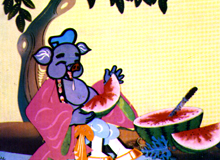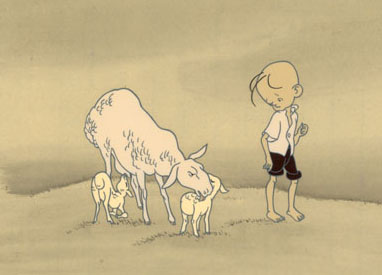 After 1977, Chinese animated films made its second leap.
After 1977, Chinese animated films made its second leap.
"Nezha Conquers theDragonKing," a full-length wide-screen cartoon film, directed by Wang Shuchen, Yan Dingxian, and Xu jingda, is typical of the work in that period. Adapted from a classic novel "Apotheosis of Heroes, " the film told a tale about the battle between a little hero and the dragon king.
The film unfolds its exciting plot step by step, from the birth of Nezha to his struggles against the dragon king. With marvelous landscapes, radiant colors, and superb photography, the film was well acclaimed by Chinese and foreign audiences. When it was shown at the Cannes Film Festival, the audience cheered for a long time, and the critics considered it was bright in color, elegant in style, and rich in imagination.
"Three Monks," directed by A Da, is an adaptation of a folk proverb: One monk will shoulder two buckets of water, two monks will share the load, but add a third, and no one will want to fetch the water. With a simple and fresh directing style, the film depicted the comparisons of the three monks' different attitudes when in different situations.

Vivid details, expressive movements, and distinctive characters combined to make an excellent cartoon film. Without any dialogue, the music played an important role in the film, which integrated the flavor ofBuddhismwith modern style, and portrayed lively characters. The film won theMinistry of Culture's Outstanding Film Prize, the Best Animated Film Prize at the First Golden Rooster Awards, and four international prizes. It is one of the Chinese animated films that have won the most prizes.
Many other animated films also shined with their own charm, including "Monkeys Fishing for the Moon" (directed by Zhou Keqin), "The Deer's Bell" (an ink-and-wash animated film directed by Tang Cheng and Wu Qiang), "The Fight between the Snipe and the Clam" (directed by Hu jinqing), and "The Monkey King Conquers the Demon" (a multi-part cartoon film directed by Te Wei, Yan Dingxian and Lin Wenxiao).
The appearance of animated serials filled a gap in the field of Chinese animated films. The serials include the five-part "Inspector Black Cat" (directed by Dai Tielang), the thirteen-part paper-cut serial "Gourd Brothers" (directed by Hu jinqing), the thirteen-part "The Adventures of the Sloppy King" (directed by Qian Yunda and Yan Shanchun), and the thirteen-part puppet serial "Afanti" (directed by Qu jianfang). In the 1990s, the first epic animated film appeared in China: the 100-part serial "Young Heroes."
Besides shooting animated films independently, Chinese animated film producers also co-operated with their counterparts in Japan, the United States, Germany, France and Canada. Foreigners think highly of the techniques used in Chinese animated films, and many jointly produced films have become world famous.
